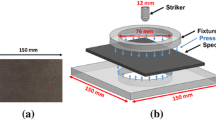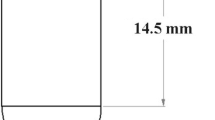Abstract
Recently, the use of Carbon Fiber Reinforced Plastic (CFRP) composite, instead of metal materials, has increased in fields that have high demand for both lightweight and high specific strength materials, such as aircraft and automobile. Composites show different characteristics according to temperature and fiber array direction. Under the operating condition, the fuselage of an aircraft is often exposed to impacts from birds, hail etc. Therefore, Charpy impact fracture characteristics of the CFRP composite according temperature and fiber array direction need to be estimated to ensure aircraft safety. In this paper, after the Charpy impact tests, fractured surfaces were analyzed to estimate the impact fracture characteristics of the CFRP composite by SEM.
Similar content being viewed by others
References
Morioka, K. and Tomita, Y., “Effect of lay-up sequences on mechanical properties and fracture behavior of CFRP laminate composites,” Materials Characterization, Vol. 45, No. 2, pp. 125–136, 2000.
Kelly, A., “Interface effects and the work of fracture of a fibrous composite,” Proc. R. Soc. Lond. A, Vol. 319, pp. 95–116, 1970.
Moloney, A. C., Kausch, H. H., and Stieger, H. R., “The fracture of particulate-filled epoxide resins,” Journal of Materials Science, Vol. 18, No. 1, pp. 208–216, 1983.
Spanoudakis, J. and Young, R. J., “Crack propagation in a glass particle-filled epoxy resin,” Journal of Materials Science, Vol. 19, pp. 473–486, 1984.
Moloney, A. C., Kausch, H. H., Kaiser, T., and Beer, H. R., “Parameters determining the strength and toughness of particulate filled epoxide resins,” Journal of Materials Science, Vol. 22, No. 2, pp. 381–393, 1987.
Cook, J., Gordon, J. E., Evans, C. C., and Marsh, D. M., “A Mechanism for the Control of Crack Propagation in All-Brittle Systems,” Proc. R. Soc. Lond. A, Vol. 282, pp. 508–520, 1964.
Yang, I. Y., Jeong, J. Y., and Kim, J. H., “Fracture toughness of CFRP laminated plates according to resin content,” Int. J. Precis. Eng. Manuf., Vol. 11, pp. 309–313, 2010.
Jeon, K. W., Shin, K. B., and Kim, J. S., “Evaluation of tensioncompression and tension-tension fatigue life of woven fabric glass/epoxy laminate composites used in railway vehicle,” Int. J. Precis. Eng. Manuf., Vol. 12, pp. 813–820, 2011.
ISO 179-1, “Plastics — Determination of Charpy Impact Properties,” 2000.
ASTM D3039, “Standard Test Method for Tensile Properties of Polymer Matrix Composite Materials,” 2008.
Kim, J. K., Baillie, C., Poh, J., and Mai, Y. W., “Fracture toughness of CFRP with modified epoxy resin matrices,” Composites Science and Technology, Vol. 43, pp. 283–297, 1992.
Park, H. S., “Prediction of residual life for the plain woven carbon fiber reinforced composite structure,” Ph. D. Thesis, Department of Mechanical Engineering, Sungkyunkwan University, 2011.
Kang, M. S., Seok, C. S., Koo, J. M., Hong, S. W., and Ahan, S. S., “Evaluation of the Residual Strength according to an Environmental Temperature of Impacted Carbon/Epoxy Composite Material,” Proc. of KSPE Spring Conference, pp. 1247–1248, 2011.
Aktas, M., Atas, C., Icten, B. M., and Karakuzu, R., “An Experimental Investigation of the Impact Response of Composite Laminates,” Compos. Struct., Vol. 87, pp. 307–313, 2009.
Chang, L., Zhang, Z., and Breidt, C., “Impact Resistance of Short Fibre/Particle Reinforced Epoxy,” Applied Composite Materials, Vol. 11, pp. 1–15, 2004.
Nishijima, S. and Okada, T., “Deformation Rate Dependence of Mechanical Properties of Epoxy Resin at Cryogenic Temperatures,” Cryogenics, Vol. 20, pp. 86–90, 1980.
Hosur, M. V., Waliul Islam, S. M., Vaidya, U. K., Kumar, A., Dutta, P. K., and Jeelani, S., “Dynamic punch shear characterization of plain weave graphite/epoxy composites at room and elevated temperatures,” Composite Structures, Vol. 70, No. 3, pp. 295–307, 2005.
Tomita, Y. and Tempaku, M., “Effect of Fiber Strength on Tensile Fracture Behavior,” Materials Characterization, Vol. 38, pp. 91–96, 1997.
Author information
Authors and Affiliations
Corresponding author
Rights and permissions
About this article
Cite this article
Hong, S.W., Ahn, S.S., Li, H. et al. Charpy impact fracture characteristics of CFRP composite materials according to variations of fiber array direction and temperature. Int. J. Precis. Eng. Manuf. 14, 253–258 (2013). https://doi.org/10.1007/s12541-013-0035-9
Received:
Accepted:
Published:
Issue Date:
DOI: https://doi.org/10.1007/s12541-013-0035-9




